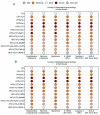Combined Metabolic Activators with Different NAD+ Precursors Improve Metabolic Functions in the Animal Models of Neurodegenerative Diseases
- PMID: 38672280
- PMCID: PMC11048203
- DOI: 10.3390/biomedicines12040927
Combined Metabolic Activators with Different NAD+ Precursors Improve Metabolic Functions in the Animal Models of Neurodegenerative Diseases
Abstract
Background: Mitochondrial dysfunction and metabolic abnormalities are acknowledged as significant factors in the onset of neurodegenerative disorders such as Parkinson's disease (PD) and Alzheimer's disease (AD). Our research has demonstrated that the use of combined metabolic activators (CMA) may alleviate metabolic dysfunctions and stimulate mitochondrial metabolism. Therefore, the use of CMA could potentially be an effective therapeutic strategy to slow down or halt the progression of PD and AD. CMAs include substances such as the glutathione precursors (L-serine and N-acetyl cysteine), the NAD+ precursor (nicotinamide riboside), and L-carnitine tartrate.
Methods: Here, we tested the effect of two different formulations, including CMA1 (nicotinamide riboside, L-serine, N-acetyl cysteine, L-carnitine tartrate), and CMA2 (nicotinamide, L-serine, N-acetyl cysteine, L-carnitine tartrate), as well as their individual components, on the animal models of AD and PD. We assessed the brain and liver tissues for pathological changes and immunohistochemical markers. Additionally, in the case of PD, we performed behavioral tests and measured responses to apomorphine-induced rotations.
Findings: Histological analysis showed that the administration of both CMA1 and CMA2 formulations led to improvements in hyperemia, degeneration, and necrosis in neurons for both AD and PD models. Moreover, the administration of CMA2 showed a superior effect compared to CMA1. This was further corroborated by immunohistochemical data, which indicated a reduction in immunoreactivity in the neurons. Additionally, notable metabolic enhancements in liver tissues were observed using both formulations. In PD rat models, the administration of both formulations positively influenced the behavioral functions of the animals.
Interpretation: Our findings suggest that the administration of both CMA1 and CMA2 markedly enhanced metabolic and behavioral outcomes, aligning with neuro-histological observations. These findings underscore the promise of CMA2 administration as an effective therapeutic strategy for enhancing metabolic parameters and cognitive function in AD and PD patients.
Keywords: Alzheimer’s disease; Parkinson’s disease; animal models; combined metabolic activators.
Conflict of interest statement
A.M., J.B. and M.U. are the founder and shareholders of ScandiBio Therapeutics. The remaining authors declare that the research was conducted in the absence of any commercial or financial relationships that could be construed as a potential conflict of interest. ScandiBio Therapeutics had no role in the design of the study; in the collection, analyses, or interpretation of data; in the writing of the manuscript, or in the decision to publish the results.
Figures





Similar articles
-
Multi-omics characterization of improved cognitive functions in Parkinson's disease patients after the combined metabolic activator treatment: a randomized, double-blinded, placebo-controlled phase II trial.Brain Commun. 2025 Jan 6;7(1):fcae478. doi: 10.1093/braincomms/fcae478. eCollection 2025. Brain Commun. 2025. PMID: 39816194 Free PMC article. Clinical Trial.
-
Combined metabolic activators improve metabolic functions in the animal models of neurodegenerative diseases.Life Sci. 2023 Feb 1;314:121325. doi: 10.1016/j.lfs.2022.121325. Epub 2022 Dec 26. Life Sci. 2023. Retraction in: Life Sci. 2024 Jul 15;349:122712. doi: 10.1016/j.lfs.2024.122712. PMID: 36581096 Retracted.
-
Combined metabolic activators improve cognitive functions in Alzheimer's disease patients: a randomised, double-blinded, placebo-controlled phase-II trial.Transl Neurodegener. 2023 Jan 26;12(1):4. doi: 10.1186/s40035-023-00336-2. Transl Neurodegener. 2023. PMID: 36703196 Free PMC article. Clinical Trial.
-
[Selective stimulations and lesions of the rat brain nuclei as the models for research of the human sleep pathology mechanisms].Glas Srp Akad Nauka Med. 2011;(51):85-97. Glas Srp Akad Nauka Med. 2011. PMID: 22165729 Review. Serbian.
-
Cellular and molecular mechanisms underlying perturbed energy metabolism and neuronal degeneration in Alzheimer's and Parkinson's diseases.Ann N Y Acad Sci. 1999;893:154-75. doi: 10.1111/j.1749-6632.1999.tb07824.x. Ann N Y Acad Sci. 1999. PMID: 10672236 Review.
Cited by
-
Vitamin B3 Ameliorates Sleep Duration and Quality in Clinical and Pre-Clinical Studies.Nutrients. 2025 Jun 12;17(12):1982. doi: 10.3390/nu17121982. Nutrients. 2025. PMID: 40573093 Free PMC article. Review.
-
Multi-omics characterization of improved cognitive functions in Parkinson's disease patients after the combined metabolic activator treatment: a randomized, double-blinded, placebo-controlled phase II trial.Brain Commun. 2025 Jan 6;7(1):fcae478. doi: 10.1093/braincomms/fcae478. eCollection 2025. Brain Commun. 2025. PMID: 39816194 Free PMC article. Clinical Trial.
-
Assessment of Subacute Toxicity of Ulexite in Rats: Behavioral, Hematological, and Biochemical Insights.Biol Trace Elem Res. 2025 Aug;203(8):4264-4272. doi: 10.1007/s12011-024-04489-7. Epub 2024 Dec 12. Biol Trace Elem Res. 2025. PMID: 39666170
References
-
- World Health Organization Dementia 2022. [(accessed on 29 October 2023)]. Available online: https://www.who.int/news-room/fact-sheets/detail/dementia.
-
- Haxaire C., Turpin F.R., Potier B., Kervern M., Sinet P.M., Barbanel G., Mothet J.P., Dutar P., Billard J.M. Reversal of age-related oxidative stress prevents hippocampal synaptic plasticity deficits by protecting D-serine-dependent NMDA receptor activation. Aging Cell. 2012;11:336–344. doi: 10.1111/j.1474-9726.2012.00792.x. - DOI - PubMed
Grants and funding
LinkOut - more resources
Full Text Sources

